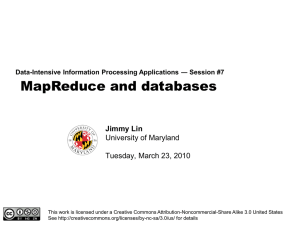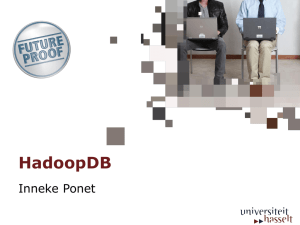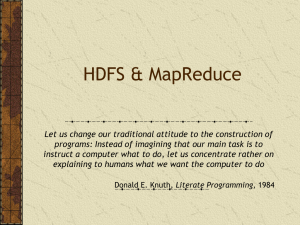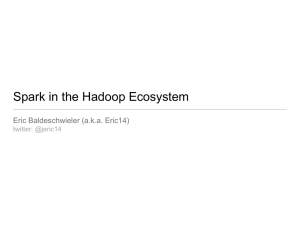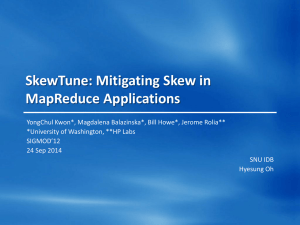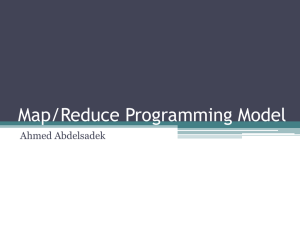PPTX - GitHub Pages
advertisement
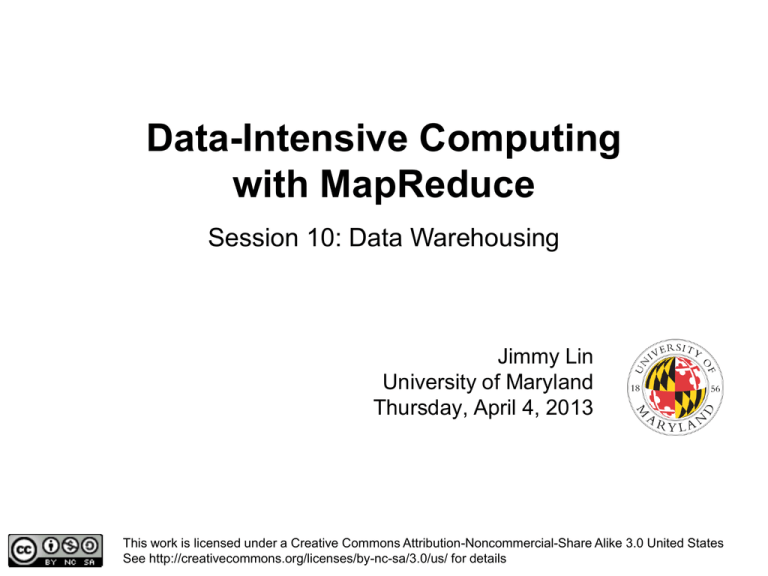
Data-Intensive Computing
with MapReduce
Session 10: Data Warehousing
Jimmy Lin
University of Maryland
Thursday, April 4, 2013
This work is licensed under a Creative Commons Attribution-Noncommercial-Share Alike 3.0 United States
See http://creativecommons.org/licenses/by-nc-sa/3.0/us/ for details
“Yesterday”
~150 people total
~60 Hadoop nodes
~6 people use analytics stack daily
“Today”
~1400 people total
10s of Ks of Hadoop nodes, multiple DCs
10s of PBs total Hadoop DW capacity
~100 TB ingest daily
dozens of teams use Hadoop daily
10s of Ks of Hadoop jobs daily
processes 20 PB a day (2008)
crawls 20B web pages a day (2012)
150 PB on 50k+ servers
running 15k apps (6/2011)
>10 PB data, 75B DB
calls per day (6/2012)
>100 PB of user data +
500 TB/day (8/2012)
Today’s Agenda
How we got here: the historical perspective
MapReduce algorithms for processing relational data
Evolving roles of relational databases and MapReduce
How we get here…
Source: www.flickr.com/photos/thiagoalmeida/250190676/
Source: Wikipedia (Industrial Revolution)
Source: Wikipedia
Business Intelligence
& Data Warehousing
Two Early Examples:
Source: Wikipedia (Warehouse)
Market basket analysis
Credit card fraud detection
Database Workloads
OLTP (online transaction processing)
Typical applications: e-commerce, banking, airline reservations
User facing: real-time, low latency, highly-concurrent
Tasks: relatively small set of “standard” transactional queries
Data access pattern: random reads, updates, writes (involving
relatively small amounts of data)
OLAP (online analytical processing)
Typical applications: business intelligence, data mining
Back-end processing: batch workloads, less concurrency
Tasks: complex analytical queries, often ad hoc
Data access pattern: table scans, large amounts of data per query
One Database or Two?
Downsides of co-existing OLTP and OLAP workloads
Poor memory management
Conflicting data access patterns
Variable latency
Solution: separate databases
User-facing OLTP database for high-volume transactions
Data warehouse for OLAP workloads
How do we connect the two?
OLTP/OLAP Architecture
ETL
(Extract, Transform, and Load)
OLTP
OLAP
OLTP/OLAP Integration
OLTP database for user-facing transactions
Extract-Transform-Load (ETL)
Extract records from source
Transform: clean data, check integrity, aggregate, etc.
Load into OLAP database
OLAP database for data warehousing
Three Classes of Activities
Dashboards
Ad hoc analyses
Data products
Structure of Data Warehouses
SELECT P.Brand, S.Country,
SUM(F.Units_Sold)
FROM Fact_Sales F
INNER JOIN Dim_Date D ON F.Date_Id = D.Id
INNER JOIN Dim_Store S ON F.Store_Id = S.Id
INNER JOIN Dim_Product P ON F.Product_Id = P.Id
WHERE D.YEAR = 1997 AND P.Product_Category = 'tv'
GROUP BY P.Brand, S.Country;
Source: Wikipedia (Star Schema)
OLAP Cubes
Common operations
product
slice and dice
roll up/drill down
pivot
store
OLAP Cubes: Research Challenges
Fundamentally, lots of group-bys and aggregations
How to take advantage of schema structure to avoid repeated
work?
Cube materialization
Realistic to materialize the entire cube?
If not, how/when/what to materialize?
Fast forward…
Jeff Hammerbacher, Information Platforms and the Rise of the Data
Scientist.
In, Beautiful Data, O’Reilly, 2009.
“On the first day of logging the Facebook clickstream, more than 400 gigabytes of
data was collected. The load, index, and aggregation processes for this data set
really taxed the Oracle data warehouse. Even after significant tuning, we were
unable to aggregate a day of clickstream data in less than 24 hours.”
What’s changed?
Dropping cost of disks
Types of data collected
Large increase in data volume
Growing maturity of data mining techniques
From data that’s obviously valuable to data whose value is less
apparent
Rise of social media and user-generated content
Cheaper to store everything than to figure out what to throw away
Demonstrates value of data analytics
Virtuous product growth cycle
ETL Bottleneck
ETL is typically a nightly task:
What happens if processing 24 hours of data takes longer than 24
hours?
Hadoop is perfect:
Ingest is limited by speed of HDFS
Scales out with more nodes
Massively parallel
Ability to use any processing tool
Much cheaper than parallel databases
ETL is a batch process anyway!
MapReduce algorithms
for processing relational data
Source: www.flickr.com/photos/stikatphotography/1590190676/
Source: www.flickr.com/photos/7518432@N06/2237536651/
Design Pattern: Secondary Sorting
MapReduce sorts input to reducers by key
Values are arbitrarily ordered
What if want to sort value also?
E.g., k → (v1, r), (v3, r), (v4, r), (v8, r)…
Secondary Sorting: Solutions
Solution 1:
Buffer values in memory, then sort
Why is this a bad idea?
Solution 2:
“Value-to-key conversion” design pattern:
form composite intermediate key, (k, v1)
Let execution framework do the sorting
Preserve state across multiple key-value pairs to handle
processing
Anything else we need to do?
Value-to-Key Conversion
Before
k → (v1, r), (v4, r), (v8, r), (v3, r)…
Values arrive in arbitrary order…
After
(k, v1) → (v1, r)
(k, v3) → (v3, r)
(k, v4) → (v4, r)
(k, v8) → (v8, r)
…
Values arrive in sorted order…
Process by preserving state across multiple keys
Remember to partition correctly!
Relational Databases
A relational database is comprised of tables
Each table represents a relation = collection of tuples
(rows)
Each tuple consists of multiple fields
Working Scenario
Two tables:
User demographics (gender, age, income, etc.)
User page visits (URL, time spent, etc.)
Analyses we might want to perform:
Statistics on demographic characteristics
Statistics on page visits
Statistics on page visits by URL
Statistics on page visits by demographic characteristic
…
Relational Algebra
Primitives
Projection ()
Selection ()
Cartesian product ()
Set union ()
Set difference ()
Rename ()
Other operations
Join (⋈)
Group by… aggregation
…
Projection
R1
R1
R2
R2
R3
R4
R5
R3
R4
R5
Projection in MapReduce
Easy!
Map over tuples, emit new tuples with appropriate attributes
No reducers, unless for regrouping or resorting tuples
Alternatively: perform in reducer, after some other processing
Basically limited by HDFS streaming speeds
Speed of encoding/decoding tuples becomes important
Take advantage of compression when available
Semistructured data? No problem!
Selection
R1
R2
R3
R4
R5
R1
R3
Selection in MapReduce
Easy!
Map over tuples, emit only tuples that meet criteria
No reducers, unless for regrouping or resorting tuples
Alternatively: perform in reducer, after some other processing
Basically limited by HDFS streaming speeds
Speed of encoding/decoding tuples becomes important
Take advantage of compression when available
Semistructured data? No problem!
Group by… Aggregation
Example: What is the average time spent per URL?
In SQL:
SELECT url, AVG(time) FROM visits GROUP BY url
In MapReduce:
Map over tuples, emit time, keyed by url
Framework automatically groups values by keys
Compute average in reducer
Optimize with combiners
Relational Joins
Source: Microsoft Office Clip Art
Relational Joins
R1
S1
R2
S2
R3
S3
R4
S4
R1
S2
R2
S4
R3
S1
R4
S3
Types of Relationships
Many-to-Many
One-to-Many
One-to-One
Join Algorithms in MapReduce
Reduce-side join
Map-side join
In-memory join
Striped variant
Memcached variant
Reduce-side Join
Basic idea: group by join key
Map over both sets of tuples
Emit tuple as value with join key as the intermediate key
Execution framework brings together tuples sharing the same key
Perform actual join in reducer
Similar to a “sort-merge join” in database terminology
Two variants
1-to-1 joins
1-to-many and many-to-many joins
Reduce-side Join: 1-to-1
Map
keys
values
R1
R1
R4
R4
S2
S2
S3
S3
Reduce
keys
values
R1
S2
S3
R4
Note: no guarantee if R is going to come first or S
Reduce-side Join: 1-to-many
Map
keys
values
R1
R1
S2
S2
S3
S3
S9
S9
Reduce
keys
values
R1
S2
S3
…
Reduce-side Join: V-to-K Conversion
In reducer…
keys
values
R1
S2
New key encountered: hold in memory
Cross with records from other set
S3
S9
R4
S3
S7
New key encountered: hold in memory
Cross with records from other set
Reduce-side Join: many-to-many
In reducer…
keys
values
R1
R5
Hold in memory
R8
S2
S3
S9
Cross with records from other set
Map-side Join: Basic Idea
Assume two datasets are sorted by the join key:
R1
S2
R2
S4
R4
S3
R3
S1
A sequential scan through both datasets to join
(called a “merge join” in database terminology)
Map-side Join: Parallel Scans
If datasets are sorted by join key, join can be
accomplished by a scan over both datasets
How can we accomplish this in parallel?
In MapReduce:
Partition and sort both datasets in the same manner
Map over one dataset, read from other corresponding partition
No reducers necessary (unless to repartition or resort)
Consistently partitioned datasets: realistic to expect?
In-Memory Join
Basic idea: load one dataset into memory, stream over
other dataset
Works if R << S and R fits into memory
Called a “hash join” in database terminology
MapReduce implementation
Distribute R to all nodes
Map over S, each mapper loads R in memory, hashed by join key
For every tuple in S, look up join key in R
No reducers, unless for regrouping or resorting tuples
In-Memory Join: Variants
Striped variant:
R too big to fit into memory?
Divide R into R1, R2, R3, … s.t. each Rn fits into memory
Perform in-memory join: n, Rn ⋈ S
Take the union of all join results
Memcached join:
Load R into memcached
Replace in-memory hash lookup with memcached lookup
Memcached
Circa 2008 Architecture
Caching servers: 15 million requests per second,
95% handled by memcache (15 TB of RAM)
Database layer: 800 eight-core Linux servers
running MySQL (40 TB user data)
Source: Technology Review (July/August, 2008)
Memcached Join
Memcached join:
Capacity and scalability?
Load R into memcached
Replace in-memory hash lookup with memcached lookup
Memcached capacity >> RAM of individual node
Memcached scales out with cluster
Latency?
Memcached is fast (basically, speed of network)
Batch requests to amortize latency costs
Source: See tech report by Lin et al. (2009)
Which join to use?
In-memory join > map-side join > reduce-side join
Why?
Limitations of each?
In-memory join: memory
Map-side join: sort order and partitioning
Reduce-side join: general purpose
Processing Relational Data: Summary
MapReduce algorithms for processing relational data:
Group by, sorting, partitioning are handled automatically by
shuffle/sort in MapReduce
Selection, projection, and other computations (e.g., aggregation),
are performed either in mapper or reducer
Multiple strategies for relational joins
Complex operations require multiple MapReduce jobs
Example: top ten URLs in terms of average time spent
Opportunities for automatic optimization
MapReduce algorithms
for processing relational data
Source: www.flickr.com/photos/7518432@N06/2237536651/
Need for High-Level Languages
Hadoop is great for large-data processing!
But writing Java programs for everything is verbose and slow
Data scientists don’t want to write Java
Solution: develop higher-level data processing languages
Hive: HQL is like SQL
Pig: Pig Latin is a bit like Perl
Hive and Pig
Hive: data warehousing application in Hadoop
Pig: large-scale data processing system
Query language is HQL, variant of SQL
Tables stored on HDFS with different encodings
Developed by Facebook, now open source
Scripts are written in Pig Latin, a dataflow language
Programmer focuses on data transformations
Developed by Yahoo!, now open source
Common idea:
Provide higher-level language to facilitate large-data processing
Higher-level language “compiles down” to Hadoop jobs
Hive: Example
Hive looks similar to an SQL database
Relational join on two tables:
Table of word counts from Shakespeare collection
Table of word counts from the bible
SELECT s.word, s.freq, k.freq FROM shakespeare s
JOIN bible k ON (s.word = k.word) WHERE s.freq >= 1 AND k.freq >= 1
ORDER BY s.freq DESC LIMIT 10;
the
I
and
to
of
a
you
my
in
is
25848
23031
19671
18038
16700
14170
12702
11297
10797
8882
Source: Material drawn from Cloudera training VM
62394
8854
38985
13526
34654
8057
2720
4135
12445
6884
Hive: Behind the Scenes
SELECT s.word, s.freq, k.freq FROM shakespeare s
JOIN bible k ON (s.word = k.word) WHERE s.freq >= 1 AND k.freq >= 1
ORDER BY s.freq DESC LIMIT 10;
(Abstract Syntax Tree)
(TOK_QUERY (TOK_FROM (TOK_JOIN (TOK_TABREF shakespeare s) (TOK_TABREF bible k) (= (. (TOK_TABLE_OR_COL s)
word) (. (TOK_TABLE_OR_COL k) word)))) (TOK_INSERT (TOK_DESTINATION (TOK_DIR TOK_TMP_FILE)) (TOK_SELECT
(TOK_SELEXPR (. (TOK_TABLE_OR_COL s) word)) (TOK_SELEXPR (. (TOK_TABLE_OR_COL s) freq)) (TOK_SELEXPR (.
(TOK_TABLE_OR_COL k) freq))) (TOK_WHERE (AND (>= (. (TOK_TABLE_OR_COL s) freq) 1) (>= (. (TOK_TABLE_OR_COL k)
freq) 1))) (TOK_ORDERBY (TOK_TABSORTCOLNAMEDESC (. (TOK_TABLE_OR_COL s) freq))) (TOK_LIMIT 10)))
(one or more of MapReduce jobs)
Hive: Behind the Scenes
STAGE DEPENDENCIES:
Stage-1 is a root stage
Stage-2 depends on stages: Stage-1
Stage-0 is a root stage
STAGE PLANS:
Stage: Stage-1
Map Reduce
Alias -> Map Operator Tree:
s
TableScan
alias: s
Filter Operator
predicate:
expr: (freq >= 1)
type: boolean
Reduce Output Operator
key expressions:
expr: word
type: string
sort order: +
Map-reduce partition columns:
expr: word
type: string
tag: 0
value expressions:
expr: freq
type: int
expr: word
type: string
k
TableScan
alias: k
Filter Operator
predicate:
expr: (freq >= 1)
type: boolean
Reduce Output Operator
key expressions:
expr: word
type: string
sort order: +
Map-reduce partition columns:
expr: word
type: string
tag: 1
value expressions:
expr: freq
type: int
Stage: Stage-2
Map Reduce
Alias -> Map Operator Tree:
hdfs://localhost:8022/tmp/hive-training/364214370/10002
Reduce Output Operator
key expressions:
expr: _col1
type: int
sort order: tag: -1
value expressions:
expr: _col0
type: string
expr: _col1
type: int
expr: _col2
type: int
Reduce Operator Tree:
Extract
Limit
File Output Operator
compressed: false
GlobalTableId: 0
table:
input format: org.apache.hadoop.mapred.TextInputFormat
output format: org.apache.hadoop.hive.ql.io.HiveIgnoreKeyTextOutputFormat
Reduce Operator Tree:
Join Operator
condition map:
Inner Join 0 to 1
condition expressions:
0 {VALUE._col0} {VALUE._col1}
1 {VALUE._col0}
outputColumnNames: _col0, _col1, _col2
Filter Operator
predicate:
Stage: Stage-0
expr: ((_col0 >= 1) and (_col2 >= 1))
Fetch Operator
type: boolean
limit: 10
Select Operator
expressions:
expr: _col1
type: string
expr: _col0
type: int
expr: _col2
type: int
outputColumnNames: _col0, _col1, _col2
File Output Operator
compressed: false
GlobalTableId: 0
table:
input format: org.apache.hadoop.mapred.SequenceFileInputFormat
output format: org.apache.hadoop.hive.ql.io.HiveSequenceFileOutputFormat
Pig: Example
Task: Find the top 10 most visited pages in each category
Visits
Url Info
User
Url
Time
Url
Category
PageRank
Amy
cnn.com
8:00
cnn.com
News
0.9
Amy
bbc.com
10:00
bbc.com
News
0.8
Amy
flickr.com
10:05
flickr.com
Photos
0.7
Fred
cnn.com
12:00
espn.com
Sports
0.9
Pig Slides adapted from Olston et al. (SIGMOD 2008)
Pig Query Plan
Load Visits
Group by url
Foreach url
generate count
Load Url Info
Join on url
Group by category
Foreach category
generate top10(urls)
Pig Slides adapted from Olston et al. (SIGMOD 2008)
Pig Script
visits = load ‘/data/visits’ as (user, url, time);
gVisits = group visits by url;
visitCounts = foreach gVisits generate url, count(visits);
urlInfo = load ‘/data/urlInfo’ as (url, category, pRank);
visitCounts = join visitCounts by url, urlInfo by url;
gCategories = group visitCounts by category;
topUrls = foreach gCategories generate top(visitCounts,10);
store topUrls into ‘/data/topUrls’;
Pig Slides adapted from Olston et al. (SIGMOD 2008)
Pig Script in Hadoop
Map1
Load Visits
Group by url
Reduce1
Foreach url
generate count
Map2
Load Url Info
Join on url
Group by category
Foreach category
generate top10(urls)
Pig Slides adapted from Olston et al. (SIGMOD 2008)
Reduce2
Map3
Reduce3
What’s the role of MapReduce?
Source: www.flickr.com/photos/rosipaw/4643095630/
Where Does Hadoop Go?
ETL
(Extract, Transform, and Load)
OLTP
OLAP
A Major Step Backwards?
MapReduce is a step backward in database access:
Schemas are good
Separation of the schema from the application is good
High-level access languages are good
MapReduce is poor implementation
Brute force and only brute force (no indexes, for example)
MapReduce is not novel
MapReduce is missing features
Bulk loader, indexing, updates, transactions…
MapReduce is incompatible with DMBS tools
Source: Blog post by DeWitt and Stonebraker
“there are known knowns; there are things we know we know.
We also know there are known unknowns; that is to say we
know there are some things we do not know. But there are
unknown unknowns – the ones we don't know we don't
know…” – Donald Rumsfeld
Source: Wikipedia
Known and Unknown Unknowns
Databases only help if you know what questions to ask
“Known unknowns”
What’s if you don’t know what you’re looking for?
“Unknown unknowns”
OLTP/OLAP/Hadoop Architecture
ETL
(Extract, Transform, and Load)
OLTP
Hadoop
OLAP
(Interesting to observe evolution of database companies’ view of Hadoop)
ETL: Redux
Often, with noisy datasets, ETL is the analysis!
Note that ETL necessarily involves brute force data scans
L, then E and T?
Structure of Hadoop Warehouses
Don’t normalize!
Source: Wikipedia (Star Schema)
A Major Step Backwards?
MapReduce is a step backward in database access:
Schemas are good
Separation of the schema from the application is good
High-level access languages are good
MapReduce is poor implementation
Brute force and only brute force (no indexes, for example)
MapReduce is not novel
MapReduce is missing features
Bulk loader, indexing, updates, transactions…
MapReduce is incompatible with DMBS tools
Bottom line: issue of maturity, not fundamental capability!
Source: Blog post by DeWitt and Stonebraker
Projection in MapReduce
R1
R1
R2
R2
R3
R4
R5
R3
R4
R5
Can we do better than brute force?
Selection in MapReduce
R1
R2
R3
R4
R1
R3
R5
Can we do better than brute force?
Relational Joins in MapReduce
R1
S1
R2
S2
R3
S3
R4
S4
R1
S2
R2
S4
R3
S1
R4
S3
Query optimizers to the rescue!
Relational Databases vs. MapReduce
Relational databases:
Multipurpose: analysis and transactions; batch and interactive
Data integrity via ACID transactions
Lots of tools in software ecosystem (for ingesting, reporting, etc.)
Supports SQL (and SQL integration, e.g., JDBC)
Automatic SQL query optimization
MapReduce (Hadoop):
Designed for large clusters, fault tolerant
Data is accessed in “native format”
Supports many query languages
Programmers retain control over performance
Open source
Source: O’Reilly Blog post by Joseph Hellerstein (11/19/2008)
Philosophical Differences
Parallel relational databases
Schema on write
Failures are relatively infrequent
“Possessive” of data
Mostly proprietary
MapReduce
Schema on read
Failures are relatively common
In situ data processing
Open source
Today’s Agenda
How we got here: the historical perspective
MapReduce algorithms for processing relational data
Evolving roles of relational databases and MapReduce
Questions?
Source: Wikipedia (Japanese rock garden)
